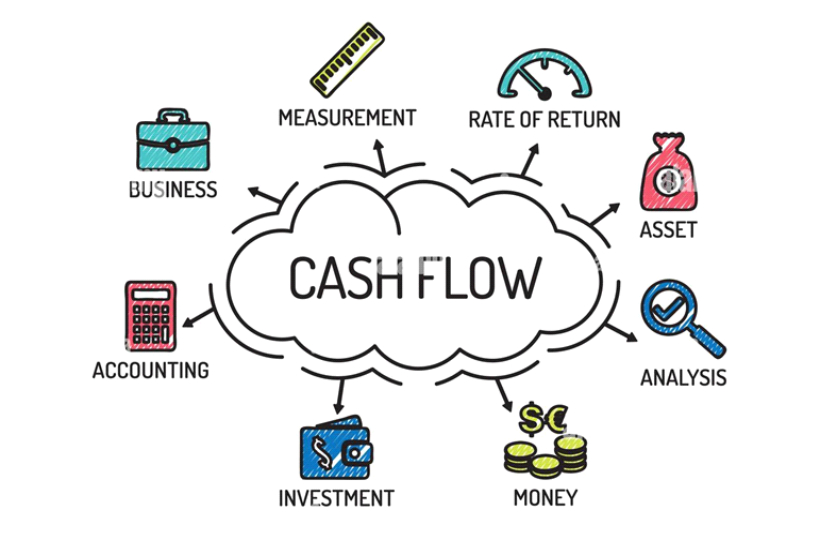
In the world of startups, cash is undeniably king. While big ideas and passion drive founders, it's cash flow management that often determines the sustainability and success of a new venture. Many promising startups have floundered not because of a lack of innovation, but because of cash flow mismanagement. Let's dive deep into this topic and make it simple with practical examples.
Cash flow refers to the movement of money in and out of your business. It's essentially the heartbeat of your startup.
Money coming into the business from sales, investments, loans, or other income sources.
Money going out, including expenses such as salaries, rent, marketing costs, and other overheads.
Imagine your startup sells an online course for $100. Every month, you get 100 students enrolling, which means $10,000 flowing into the business. However, you spend $7,000 on marketing, platform fees, and other costs, which is your outflow. The difference ($3,000) is your net positive cash flow for that month.
While profit is important, a business can be profitable on paper but still face issues if cash isn’t available at the necessary times. Cash flow management ensures that you have sufficient cash to meet all your obligations, such as paying suppliers and employees.

This refers to how quickly assets (like stocks or receivables) can be turned into cash. High liquidity means assets can be quickly converted without much loss in value.
Commonly used in startups, this refers to the rate at which a company is spending its capital until it reaches profitability. If your startup has $100,000 in the bank and spends $10,000 a month, it has a burn rate of $10,000.
This is the cash generated from the regular business operations – basically, sales minus operational expenses.
Money owed to a company by its customers. If you've delivered a product or service but haven't been paid yet, this amount appears as AR in your balance sheet.
Money a company owes to suppliers. If you've received goods or services but haven't paid for them yet, this amount shows up as AP.
The difference between current assets (like cash, inventory, and AR) and current liabilities (like AP). It indicates a company's short-term financial health.
How long it takes, in days, to turn your inventory purchases into cash. A shorter cycle is generally better as it means you're converting your inventory to cash quickly.
On average, how many days it takes to collect payment after a sale has been made. A high DSO might indicate that a company's collection processes are inefficient.
How long it takes a company to pay its invoices from trade creditors, such as suppliers.
On average, the number of days it takes for a company to sell its inventory.
The amount of cash a company has left over after paying for its operating expenses and capital expenditures. FCF can be reinvested into the business or returned to shareholders.
This metric provides a view into a company's operational performance by showing earnings from its core business operations.
The point where total revenues equal total costs, meaning the business is neither making a profit nor incurring a loss.
Sales revenue minus the cost of goods sold (COGS). It shows how efficiently a business is producing its goods.
The percentage of revenue remaining after all operating expenses, interest, taxes, and other expenses have been deducted.
Money spent by a company to acquire or upgrade long-term assets like property, plants, or equipment.
All costs associated with the day-to-day operations of a business, not including the cost of goods sold.
A line of credit that allows businesses to borrow, repay, and then borrow again up to a set limit.
Project or plan your cash flow for the next few months or even a year. Factor in expected sales, fixed costs, and variable expenses.
Example: If you expect a large client to delay their payment by a month, it might affect your ability to pay your team. A forecast helps you see this in advance.
Just as individuals are advised to have savings for unexpected events, businesses too should maintain a reserve.
Regularly compare your forecasted cash flow with the actual figures. This will help you understand if your projections are too optimistic or pessimistic and adjust accordingly.
Regularly review and identify areas where expenses can be reduced without compromising on quality.
Example: Can you negotiate a better deal with suppliers? Or perhaps opt for more cost-effective marketing strategies?
Ensure that you're invoicing clients as soon as work is completed. The sooner you invoice, the sooner you're likely to get paid. Remember the clients wont understand their obligation to pay until they receive a clear invoice.
Offer discounts for early payments or adopt digital payment methods which can speed up the process.
While it’s essential to pay obligations on time, if there's an opportunity to delay an outflow without penalty or straining a business relationship, consider it.
Example: If a supplier gives you 30 days to pay, use the full period if it benefits your cash flow, but always pay within the stipulated time.
Establish a line of credit or explore other financing options before there's a cash crunch.
At its core, cash flow management is about ensuring that at any given time, your inflows match or exceed your outflows. For startup founders, understanding the intricacies of cash flow can be the difference between thriving and just surviving. By following the above tips and constantly educating yourself, you'll be better positioned to navigate the financial challenges of the startup world. Remember, in business, cash isn’t just king—it’s the entire kingdom!